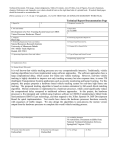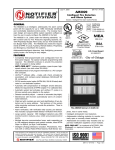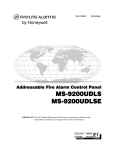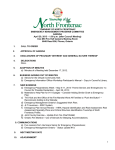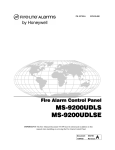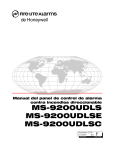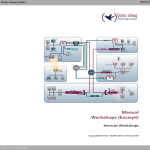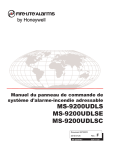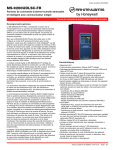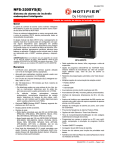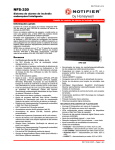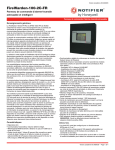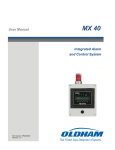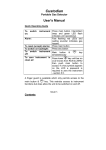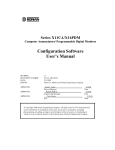Download ms-9200udls 04/23/09 1 engineering specification 198
Transcript
ENGINEERING SPECIFICATION 198-POINT INTELLIGENT COMMUNICATING FIRE DETECTION SYSTEM PART 1.0 - GENERAL 1.1. DESCRIPTION: A. This section of the specification includes the furnishing, installation, connection and testing of the microprocessor controlled, intelligent reporting fire alarm equipment required to form a complete, operative, coordinated system. It shall include, but not be limited to, alarm initiating devices, alarm notification appliances, Fire Alarm Control Panel (FACP), auxiliary control devices, annunciators, Ethernet and/or digital alarm communications to central stations and wiring as shown on the drawings and specified herein. B. The fire alarm system shall comply with requirements of NFPA Standard No. 72 for Local Protected Premises Signaling Systems except as modified and supplemented by this specification. The system field wiring shall be supervised either electrically or by software-directed polling of field devices. 1. The Secondary Power Source of the fire alarm control panel will be capable of providing at least 24 hours of backup power with the ability to sustain 5 minutes in alarm at the end of the backup period. C. The fire alarm system shall be manufactured by an ISO 9001 certified company and meet the requirements of BS EN9001: ANSI/ASQC Q9001-1994. D. The FACP and peripheral devices shall be manufactured or supplied 100% by a single U.S. manufacturer (or division thereof). E. Underwriters Laboratories Inc. (UL) - USA: No. 38 Manually Actuated Signaling Boxes No. 50 Cabinets and Boxes No. 864 Control Units for Fire Protective Signaling Systems No. 268 Smoke Detectors for Fire Protective Signaling Systems No. 268A Smoke Detectors for Duct Applications No. 346 Waterflow Indicators for Fire Protective Signaling Systems No. 464 Audible Signaling Appliances No. 521 Heat Detectors for Fire Protective Signaling Systems No. 1971 Visual Notification Appliances F. The installing company shall employ NICET (minimum Level II Fire Alarm Technology) technicians on site to guide the final check-out and to ensure the systems integrity. G. The FACP shall meet requirements of UL ANSI 864 Ninth Edition MS-9200UDLS 04/23/09 1 1.2. SCOPE: A. An intelligent, microprocessor-controlled, fire alarm detection system shall be installed in accordance to the project specifications and drawings. B. Basic Performance: 1. Initiation Device Circuits (IDC) shall be wired Class B (NFPA Style B) as part of an addressable device connected by the SLC Circuit. 2. Notification Appliance Circuits (NAC) shall be wired Class B (NFPA Style Y) as part of an addressable device connected by the SLC Circuit. 3. All circuits shall be power-limited, per UL864 requirements. 4. A single ground fault or open circuit on the system Signaling Line Circuit shall not cause system malfunction, loss of operating power or the ability to report an alarm. 5. Alarm signals arriving at the main FACP shall not be lost following a primary power failure or outage of any kind until the alarm signal is processed and recorded. C. BASIC SYSTEM FUNCTIONAL OPERATION When a fire alarm condition is detected and reported by one of the system initiating devices, the following functions shall immediately occur: 1. The system Alarm LED on the FACP shall flash. 2. A local sounder with the control panel shall sound. 3. A backlit 80-character LCD display on the FACP shall indicate all information associated with the fire alarm condition, including the type of alarm point and its location within the protected premises. 4. In response to a fire alarm condition, the system will process all control programming and activate all system outputs (alarm notification appliances and/or relays) associated with the point(s) in alarm. Additionally, the system shall send events to a central alarm supervising station via either dial-up over PSTN or Internet or Intranet via PSDN or virtual private network. 1.3. SUBMITTALS A. General: MS-9200UDLS 04/23/09 2 1. Two copies of all submittals shall be submitted to the Architect/Engineer for review. 2. All references to manufacturer's model numbers and other pertinent information herein is intended to establish minimum standards of performance, function and quality. Equivalent compatible UL-listed equipment from other manufacturers may be substituted for the specified equipment as long as the minimum standards are met. 3. For equipment other than that specified, the contractor shall supply proof that such substitute equipment equals or exceeds the features, functions, performance, and quality of the specified equipment. B. Shop Drawings: 1. Sufficient information, clearly presented, shall be included to determine compliance with drawings and specifications. 2. Include manufacturer's name(s), model numbers, ratings, power requirements, equipment layout, device arrangement, complete wiring point-to-point diagrams, and conduit layouts. 3. Show annunciator layout, configurations, and terminations. C. Manuals: 1. Submit simultaneously with the shop drawings, complete operating and maintenance manuals listing the manufacturer's name(s), including technical data sheets. 2. Wiring diagrams shall indicate internal wiring for each device and the interconnections between the items of equipment. 3. Provide a clear and concise description of operation that gives, in detail, the information required to properly operate the equipment and system. D. Software Modifications 1. Provide the services of a qualified technician to perform all system software modifications, upgrades or changes. Response time of the technician to the site shall not exceed 4 hours. 2. Provide all hardware, software, programming tools and documentation necessary to modify the fire alarm system on site. Modification includes addition and deletion of devices, circuits, zones and changes to system operation and custom MS-9200UDLS 04/23/09 3 label changes for devices or zones. The system structure and software shall place no limit on the type or extent of software modifications on-site. Modification of software shall not require power-down of the system or loss of system fire protection while modifications are being made. 1.4. GUARANTY: All work performed and all material and equipment furnished under this contract shall be free from defects and shall remain so for a period of at least one (1) year from the date of acceptance. The full cost of maintenance, labor and materials required to correct any defect during this one year period shall be included in the submittal bid. 1.5. MAINTENANCE: A. Maintenance and testing shall be on a semi-annual schedule or as required by the local AHJ. A preventive maintenance schedule shall be provided by the contractor describing the protocol for preventive maintenance. The schedule shall include: 1. Systematic examination, adjustment and cleaning of all detectors, manual fire alarm stations, control panels, power supplies, relays, waterflow switches and all accessories of the fire alarm system. 2. Each circuit in the fire alarm system shall be tested semiannually. 3. Each smoke detector shall be tested in accordance with the requirements of NFPA 72 Chapter 10. B. As part of the bid/proposal, include a quote for a maintenance contract to provide all maintenance, tests, and repairs described below. Include also a quote for unscheduled maintenance/repairs, including hourly rates for technicians trained on this equipment and response travel costs for each year of the maintenance period. Submittals that do not identify all post contract maintenance costs will not be accepted. Rates and costs shall be valid for the period of five (5) years after expiration of the guaranty. 1.6. POST CONTRACT EXPANSIONS: A. The contractor shall have the ability to provide parts and labor to expand the system specified, if so requested, for a period of five (5) years from the date of acceptance. B. As part of the submittal, include a quotation for all parts and material, and all installation and test labor as needed to increase the number of intelligent or addressable devices by ten percent (10%). This quotation shall include intelligent MS-9200UDLS 04/23/09 4 smoke detectors, intelligent heat detectors, addressable manual stations, addressable beam detectors, addressable monitor modules and addressable control modules equal in number to one tenth of the number required to meet this specification (list actual quantity of each type). C. The quotation shall include installation, test labor, and labor to reprogram the system for this 10% expansion. If additional FACP hardware is required, include the material and labor necessary to install this hardware. D. Do not include cost of conduit or wire or the cost to install conduit or wire except for labor to make final connections at the FACP and at each intelligent addressable device. Do not include the cost of conventional peripherals or the cost of initiating devices or notification appliances connected to the addressable monitor/control modules. E. Submittals that do not include this estimate of post contract expansion cost will not be accepted. 1.7. APPLICABLE STANDARDS AND SPECIFICATIONS: The specifications and standards listed below form a part of this specification. The system shall fully comply with the latest issue of these standards, if applicable. A. National Fire Protection Association (NFPA) - USA: No. 13 Sprinkler Systems No. 70 National Electric Code (NEC) No. 72 National Fire Alarm Code No. 101 Life Safety Code No. 38 Manually Actuated Signaling Boxes No. 217 Smoke Detectors, Single and Multiple Station No. 228 Door Closers–Holders for Fire Protective Signaling Systems No. 268 Smoke Detectors for Fire Protective Signaling Systems No. 268A Smoke Detectors for Duct Applications No. 346 Waterflow Indicators for Fire Protective Signaling Systems No. 464 Audible Signaling Appliances No. 521 Heat Detectors for Fire Protective Signaling Systems No. 864 Control Units for Fire Protective Signaling Systems No. 1481 Power Supplies for Fire Protective Signaling Systems No. 1610 Central Station Burglar Alarm Units No. 1638 Visual Signaling Appliances No. 1971 Visual Signaling Appliances No. 2017 General-Purpose Signaling Devices and Systems CAN/ULC S524-01 Standard for Installation of Fire Alarm Systems 1. The FACP shall be ANSI 864, 9th Edition Listed. Systems listed to ANSI 864, 8th edition (or previous revisions) shall not be accepted. MS-9200UDLS 04/23/09 5 B. The system and its components shall be Underwriters Laboratories, Inc. listed under the appropriate UL testing standard as listed herein for fire alarm applications and the installation shall be in compliance with the UL listing. C. Local and State Building Codes. D. All requirements of the Authority Having Jurisdiction (AHJ). 1.8. APPROVALS: A. The system shall have proper listing and/or approval from the following nationally recognized agencies: UL Underwriters Laboratories Inc FM Factory Mutual MEA Material Equipment Acceptance (NYC) CSFM California State Fire Marshal PART 2.0 PRODUCTS 2.1. EQUIPMENT AND MATERIAL, GENERAL: A. All equipment and components shall be new, and the manufacturer's current model. The materials, appliances, equipment and devices shall be tested and listed by a nationally recognized approvals agency for use as part of a fire protective signaling system, meeting the National Fire Alarm Code. B. All equipment and components shall be installed in strict compliance with manufacturers' recommendations. Consult the manufacturer's installation manuals for all wiring diagrams, schematics, physical equipment sizes, etc., before beginning system installation. C. All equipment shall be attached to walls and ceiling/floor assemblies and shall be held firmly in place (e.g., detectors shall not be supported solely by suspended ceilings). Fasteners and supports shall be adequate to support the required load. D. All equipment must be available "over the counter" through the Security Equipment Distributor (SED) market and can be installed by dealerships independent of the manufacturer. 2.2. CONDUIT AND WIRE: MS-9200UDLS 04/23/09 6 A. Conduit: 1. Conduit shall be in accordance with The National Electrical Code (NEC), local and state requirements. 2. Where required, all wiring shall be installed in conduit or raceway. Conduit fill shall not exceed 40 percent of interior cross sectional area where three or more cables are contained within a single conduit. 3. Cable must be separated from any open conductors of power, or Class 1 circuits, and shall not be placed in any conduit, junction box or raceway containing these conductors, per NEC Article 760-29. 4. Wiring for 24 volt DC control, alarm notification, emergency communication and similar power-limited auxiliary functions may be run in the same conduit as initiating and signaling line circuits. All circuits shall be provided with transient suppression devices and the system shall be designed to permit simultaneous operation of all circuits without interference or loss of signals. 5. Conduit shall not enter the fire alarm control panel, or any other remotely mounted control panel equipment or backboxes, except where conduit entry is specified by the FACP manufacturer. 6. Conduit shall be 3/4 inch (19.1 mm) minimum. B. Wire: 1. All fire alarm system wiring shall be new. 2. Wiring shall be in accordance with local, state and national codes (e.g., NEC Article 760) and as recommended by the manufacturer of the fire alarm system. Number and size of conductors shall be as recommended by the fire alarm system manufacturer, but not less than 18 AWG (1.02 mm) for Initiating Device Circuits and Signaling Line Circuits, and 14 AWG (1.63 mm) for Notification Appliance Circuits. 3. All wire and cable shall be listed and/or approved by a recognized testing agency for use with a protective signaling system. 4. Wire and cable not installed in conduit shall have a fire resistance rating suitable for the installation as indicated in NEC 760 (e.g., FPLR). 5. Wiring used for the multiplex communication circuit (SLC) shall be twisted and support a minimum wiring distance of 10,000 feet when sized at 12 AWG. The design of the system shall permit use of IDC and NAC wiring in the same MS-9200UDLS 04/23/09 7 conduit with the SLC communication circuit. Shielded wire shall not be required. 6. All field wiring (with exception of external communications Ethernet) shall be electrically supervised for open circuit and ground fault. 7. The fire alarm control panel shall be capable of T-tapping NFPA Style 4 (Class B) Signaling Line Circuits (SLCs). Systems which do not allow or have restrictions in, for example, the amount of T-taps, length of T-taps etc., is not acceptable. C. Terminal Boxes, Junction Boxes and Cabinets: All boxes and cabinets shall be UL listed for their use and purpose. D. The fire alarm control panel shall be connected to a separate dedicated branch circuit, maximum 20 amperes. This circuit shall be labeled at the main power distribution panel as FIRE ALARM. Fire alarm control panel primary power wiring shall be 12 AWG. The control panel cabinet shall be grounded securely to either a cold water pipe or grounding rod. The control panel enclosure shall feature a quick removal chassis to facilitate rapid replacement of the FACP electronics. 2.3. MAIN FIRE ALARM CONTROL PANEL: A. The FACP shall be a Fire-Lite Model MS-9200UDLS and shall contain a microprocessor-based Central Processing Unit (CPU). The CPU shall communicate with and control the following types of equipment used to make up the system: intelligent addressable smoke and thermal (heat) detectors, addressable modules, printer, annunciators, Digital Dialer and Ethernet Communicators and other system controlled devices. Ethernet communications shall be via a Fire-Lite Model IPDACT. Central station supervisory equipment shall be a Teldat Corporation Visoralarm-Plus 2U listed to UL-864 standards. B. Operator Control 1. Acknowledge Switch: a. Activation of the control panel Acknowledge switch in response to new alarms and/or troubles shall silence the local panel piezo electric signal and change the alarm and trouble LEDs from flashing mode to steady-ON mode. If multiple alarm or trouble conditions exist, depression of this switch shall advance the 80-character LCD display to the next alarm or trouble condition. b. Depression of the Acknowledge switch shall also silence all remote annunciator piezo sounders. MS-9200UDLS 04/23/09 8 2. Alarm Silence Switch: Activation of the alarm silence switch shall cause all programmed alarm notification appliances and relays to return to the normal condition after an alarm condition. The selection of notification circuits and relays that are silenceable by this switch shall be fully field programmable within the confines of all applicable standards. The FACP software shall include silence inhibit and autosilence timers. 3. Alarm Activate (Drill) Switch: The Alarm Activate switch shall activate all notification appliance circuits. The drill function shall latch until the panel is silenced or reset. 4. System Reset Switch: Activation of the System Reset switch shall cause all electronically-latched initiating devices, appliances or software zones, as well as all associated output devices and circuits, to return to their normal condition. 5. Lamp Test: The Lamp Test switch shall activate all system LEDs and light each segment of the liquid crystal display. C. System Capacity and General Operation 1. The control panel shall provide, or be capable of, expansion to 198 intelligent/addressable devices. 2. The control panel shall include Form-C Alarm, Trouble and Supervisory relays rated at a minimum of 2.0 amps @ 30 VDC. It shall also include programmable Notification Appliance Circuits (NACs) capable of being wired as NFPA Style Y (Class B) or NFPA Style Z (Class A). 3. The fire alarm control panel shall include an operator interface control and annunciation panel that shall include a backlit Liquid Crystal Display (LCD), individual color-coded system status LEDs, and an alphanumeric keypad for the field programming and control of the fire alarm system. 4. All programming or editing of the existing program in the system shall be achieved without special equipment and without interrupting the alarm monitoring functions of the fire alarm control panel. The system shall be fully programmable, configurable, and expandable in the field without the need for special tools, PROM programmers or PC based programmers. It shall not require replacement of memory ICs to facilitate programming changes. The control unit MS-9200UDLS 04/23/09 9 will support the ability to upgrade its operating program using FLASH memory technology. The unit shall provide the user with the ability to program from either the included keypad, a standard PS2-style PC keyboard or from a computer running upload/download software. 5. The system shall allow the programming of any input to activate any output or group of outputs. Systems which have limited programming (such as general alarm), have complicated programming (such as a diode matrix), are not considered suitable substitutes. 6. The FACP shall provide the following features: a. Drift compensation to extend detector accuracy over life. Drift compensation shall also include a smoothing feature, allowing transient noise signals to be filtered out. b. Detector sensitivity test, meeting requirements of NFPA 72, Maintenance alert, with two levels (maintenance alert/maintenance urgent), to warn of excessive smoke detector dirt or dust accumulation. c. The ability to display or print system reports. d. Alarm verification, with counters and a trouble indication to alert maintenance personnel when a detector enters verification an excessive number of times. e. Positive Alarm Sequence (PAS presignal), meeting NFPA 72 requirements. f. Rapid manual station reporting. g. Non-alarm points for general (non-fire) control. h. Periodic detector test, conducted automatically by the software. i. Walk test, with a check for two detectors set to same address. 7. The FACP shall be capable of coding Notification Appliance Circuits in March Time Code (120 PPM), Temporal (NFPA 72), and California Code. Main panel notification circuits shall also automatically synchronize any of the following manufacturer’s notification appliances connected to them: System Sensor, Wheelock, or Gentex with no need for additional synchronization modules B. Central Microprocessor 1. The microprocessor shall be a state-of-the-art and it shall communicate with, MS-9200UDLS 04/23/09 10 monitor and control all external interfaces. A "watch dog" timer circuit to detect and report microprocessor failure. 2. The microprocessor shall contain and execute all specific actions to be taken in the condition of an alarm. Control programming shall be held in non-volatile programmable memory, and shall not be lost even if system primary and secondary power failure occurs. 3. The microprocessor shall also provide a real-time clock for time annotation of system displays, printer, and history file. 4. A special program check function shall be provided to detect common operator errors. 5. An auto-programming capability (self-learn) shall be provided to quickly identify devices connected on the SLC and make the system operational. 6. For flexibility and to ensure program validity, an optional Windows(TM) based program utility shall be available. This program shall be used to off-line program the system with batch upload/download. This program shall also have a verification utility which scans the program files, identifying possible errors. It shall also have the ability to compare old program files to new ones, identifying differences in the two files to allow complete testing of any system operating changes. This shall be in incompliance with the NFPA 72 requirements for testing after system modification. C. Local Keyboard Interface 1. In addition to an integral keypad, the fire alarm control panel will accept a standard PS2-style keyboard for programming, testing, and control of the system. The keyboard will be able to execute the system functions ACKNOWLEDGE, SIGNALS SILENCED, DRILL and RESET. D. Display 1. The display shall provide all the controls and indicators used by the system operator and may also be used to program all system operational parameters. 2. The display shall include status information and custom alphanumeric labels for all intelligent detectors, addressable modules, internal panel circuits, and software zones. 3. The display shall contain an alphanumeric, text-type display and dedicated LEDs for the annunciation of AC POWER, FIRE ALARM, SUPERVISORY, TROUBLE, MAINTENANCE, ALARM SILENCED, DISABLED, BATTERY, MS-9200UDLS 04/23/09 11 and GROUND conditions. 4. The display keypad shall be part of the standard system and have the capability to command all system functions, entry of any alphabetic or numeric information, and field programming. Two different password levels shall be provided to prevent unauthorized system control or programming. 5. The display shall include the following operator control switches: ACKNOWLEDGE, ALARM SILENCE, DRILL (alarm activate), and SYSTEM RESET. E. Signaling Line Circuit (SLC) 1. The SLC interface shall provide power to and communicate with up to 99 intelligent detectors (ionization, photoelectric or thermal) addressable Beam Detectors, and 99 addressable pull stations, intelligent modules (monitor or control) for a system capacity of 198 devices. Each SLC shall be capable of NFPA 72 Style 4, Style 6, or Style 7 (Class A or B) wiring. 2. The CPU shall receive information from all intelligent detectors to be processed to determine whether normal, alarm, pre-alarm, or trouble conditions exist for each detector. The software shall automatically compensate for the accumulation of dust in each detector up to allowable limits. The information shall also be used for automatic detector testing and for the determination of detector maintenance conditions. 3. The detector software shall meet NFPA 72, Chapter 10 requirements and be certified by UL as a calibrated sensitivity test instrument. F. Serial Interfaces 1. The system shall provide a means of interfacing to UL Listed Electronic Data Processing (EDP) peripherals using the EIA-232 communications standard. 2. One EIA-232 interface shall be used to connect an UL-Listed 80-column printer. The printer shall communicate with the control panel using an interface complying with Electrical Industries Association standard EIA-232D. Power to the printer shall be 120 VAC @ 60 Hz. G. The control panel will have the capability of Reverse Polarity Transmission or connection to a Municipal Box for compliance with applicable NFPA standards. H. Digital Alarm Communicator Transmitter (DACT) and Internet Protocol Digital Alarm Communicator Transmitter (IPDACT). The DACT is an interface for communicating digital information between a fire alarm control panel and a ULMS-9200UDLS 04/23/09 12 Listed central station. When the optional IPDACT Ethernet module is connected to the on board DACT, the system shall be capable of transmitting contact ID formatted alarms to a central station equipped with a compatible IP receiver via Ethernet over a private or public WAN/LAN, Intranet or Ethernet 1. The IPDACT communicator shall be an integral module component of the fire alarm control panel enclosure. 2. The IPDACT communicator shall include connections to the alarm panel’s phone outputs and shall convert the contact ID protocol in DTMF form into UDP Ethernet Packets. It shall include the ability for simultaneous reporting of panel events up to three different IP addresses. 3. The IPDACT communicator shall be completely field-programmable locally from a PC via a serial port or via Ethernet and Telnet. 4. The IPDACT communicator shall be capable of transmitting events in contact ID format. 5. Communication shall include vital system status such as: - Independent Zone (Alarm, trouble, non-alarm, supervisory) Independent Addressable Device Status AC (Mains) Power Loss Low Battery and Earth Fault System Off Normal 12 and 24 Hour Test Signal Abnormal Test Signal (per UL requirements) EIA-485 Communications Failure IP Line Failure 6. The IPDACT communicator shall support independent zone/point reporting via the Contact ID format. In this format, the IPDACT shall support the transmission of addressable points within the system. This format shall enable the central station to have exact details concerning the location of the fire for emergency response. The IPDACT communicator shall be capable of providing simulated phone lines to the FACP and panel communication over IP shall be transparent to the panels normal operation over phone lines. 7. The IPDACT communicator shall utilize a supervisory heart beat signal of no less than once every 90 seconds insuring multiplexed level line supervision. Loss of Internet or Intranet connectivity shall be reported in no more than 200 seconds. Alarm events shall be transmitted to a central station in no less than 90 seconds from time of initiation to time of notification. MS-9200UDLS 04/23/09 13 8. The supervising station shall consist of a Teldat Corporation Visoralarm-Plus 2U receiver. Said receiver shall contain a smart card for backup of all account data. Backup smart card shall initiate a new receiver with all account information in Less than 60 seconds from power up. I. Stand Alone Voice Evacuation Control Panel 1. A stand alone Voice Evacuation Control Panel shall be available from the same manufacturer of the main fire alarm system. 2. This Voice Evacuation Control Panel shall work stand alone or as a slave to the Main Fire Alarm Control Panel. 3. Shall have as minimum requirements: a. Integral 25 Watt, 25 Vrms audio amplifier with optional converter for 70.7 volt systems. The system shall be capable of expansion to 50 watts total via the insertion of an additional 25 watt audio amplifier module into the same cabinet. b. Speaker circuit shall be capable of either Class A or B wiring. c. Integral Digital Message Generator with a memory capacity for up to 60 seconds of messaging. The Digital Message Generator shall be capable of producing five distinct messages (12 seconds each). These messages shall field programmable without the use of additional equipment. d. Built in alert tone generators with steady, slow whoop, high/low and chime tone field programmable. e. The Voice Evacuation Control Panel will be capable of detecting and annunciating the following conditions: Loss of Power (AC and DC), System Trouble, Ground Fault, Alarm, Microphone Trouble, Message Generator Trouble, Tone Generator Trouble, and Amplifier Fault. 4. The Voice Evacuation Control Panel shall be fully supervised including microphone, amplifier output, message generator, speaker wiring, and tone generation. 5. Speaker outputs shall be fully power-limited. 6. Amplifiers shall be independently powered and protected to eliminate a short on one circuit from affecting other circuits. 7. The Voice Evacuation Control Panel shall provide full supervision on both active (alarm or music) and standby conditions. MS-9200UDLS 04/23/09 14 8. An optional zone splitter version shall be available that permits splitting speaker circuits into 8 specific zones. 9. An optional distributed amplifier unit shall be available that permits splitting speaker circuits into up to a total of 24 zones when two distributed amplifiers are combined with the master unit. 10. An optional fire fighter telephone unit with keypad shall be available that permits up to a total of 24 telephone circuits. J. Speakers: 1. All speakers shall operate on 25 VRMS or with field selectable output taps from 0.25 to 2.0 Watts. 2. Speakers in corridors and public spaces shall produce a nominal sound output of 84 dBA at 10 feet (3m). 3. Frequency response shall be a minimum of 400 HZ to 4000 HZ. 4. The back of each speaker shall be sealed to protect the speaker cone from damage and dust. K. Enclosures: 1. The control panel shall be housed in a UL-listed cabinet suitable for surface or semi-flush mounting. The cabinet and front shall be corrosion protected and painted red via the powder coat method with manufacturer's standard finish. 2. The back box and door shall be constructed of steel with provisions for electrical conduit connections into the sides and top. 3. The door shall provide a key lock and shall provide for the viewing of all indicators. 4. The cabinet shall accept a chassis containing the PCB and to assist in quick replacement of all the electronics including power supply shall require no more than two bolts to secure the panel to the enclosure back box. L. Field Charging Power Supply: The FCPS is a device designed for use as either a remote 24-volt power supply or as a booster for powering Notification Appliances. 1. The FCPS shall offer up to 8.0 amps (6.0 amps continuous) of regulated 24 volt power. It shall include an integral charger designed to charge 18.0 amp hour batteries. MS-9200UDLS 04/23/09 15 2. The Field Charging Power Supply shall have two input triggers. The input trigger shall be a Notification Appliance Circuit (from the fire alarm control panel) or a control relay. Four NAC outputs, wired NFPA Style Y or Z, shall be available for connection to the Notification devices. 3. The FCPS shall optionally provide synchronization of all connected strobes or horn strobe combinations when either System Sensor, Wheelock or Gentex devices are installed. 4. The FCPS shall function as a sync follower as well as a sync generator. 5. The FCPS shall include a surface mount backbox. 6. The Field Charging Power Supply shall include the ability to delay the reporting of an AC fail condition per NFPA requirements. 7. The FCPS shall provide 24 VDC regulated and power-limited circuitry per UL standards. M. Power Supply: 1. The main power supply for the fire alarm control panel shall provide up to 6.0 amps of available power for the control panel and peripheral devices. 2. Provisions will be made to allow the audio-visual power to be increased as required by adding modular expansion audio-visual power supplies. 3. Positive-Temperature-Coefficient (PTC) thermistors, circuit breakers, or other over-current protection shall be provided on all power outputs. The power supply shall provide an integral battery charger or may be used with an external battery and charger systems. Battery arrangement may be configured in the field. 4. The main power supply shall continuously monitor all field wires for earth ground conditions. 5. The main power supply shall operate on 120 VAC, 60 Hz, and shall provide all necessary power for the FACP. N. Programmable Electronic Sounders: 1. Electronic sounders shall operate on 24 VDC nominal. 2. Electronic sounders shall be field programmable without the use of special tools, to provide slow whoop, continuous, or interrupted tones with an output sound level of at least 90 dBA measured at 10 feet from the device. MS-9200UDLS 04/23/09 16 3. Electronic sounders shall be flush or surface mounted as shown on plans. O. Strobe lights shall meet the requirements of the ADA, UL Standard 1971 and shall meet the following criteria: 1. The maximum pulse duration shall be 2/10 of one second. 2. Strobe intensity shall meet the requirements of UL 1971. 3. The flash rate shall meet the requirements of UL 1971. P. Audible/Visual Combination Devices: 1. Shall meet the applicable requirements of Section A listed above for audibility. 2. Shall meet the requirements of Section B listed above for visibility. Q. Specific System Operations 1. Alarm Verification: Each of the intelligent addressable smoke detectors in the system may be independently programmed for verification of alarm signals. The alarm verification time period shall not exceed 2 minutes. 2. Point Disable: Any addressable device or conventional circuit in the system may be enabled or disabled through the system keypad. 3. Point Read: The system shall be able to display the following point status diagnostic functions: a. b. c. d. Device status Device type Custom device label Device zone assignments 4. System Status Reports: Upon command from an operator of the system, a status report will be generated and printed, listing all system status. 5. System History Recording and Reporting: The fire alarm control panel shall contain a history buffer that will be capable of storing up to 1000 events. Each of these activations will be stored and time and date stamped with the actual time of the activation. The contents of the history buffer may be manually reviewed, one event at a time, or printed in its entirety. The history buffer shall use non-volatile memory. Systems that use volatile memory for history storage are not acceptable substitutes. MS-9200UDLS 04/23/09 17 6. Automatic Detector Maintenance Alert: The fire alarm control panel shall automatically interrogate each intelligent detector and shall analyze the detector responses over a period of time. If any intelligent detector in the system responds with a reading that is above or below normal limits, then the system will enter the trouble mode, and the particular detector will be annunciated on the system display. This feature shall in no way inhibit the receipt of alarm conditions in the system, nor shall it require any special hardware, special tools or computer expertise to perform. 7. Pre-Alarm Function: The system shall provide two levels of pre-alarm warning to give advance notice of a possible fire situation. Both pre-alarm levels shall be fully field adjustable. The first level shall give an audible indication at the panel. The second level shall give an audible indication and may also activate control relays. The system shall also have the ability to activate local detector sounder bases at the pre-alarm level, to assist in avoiding nuisance alarms. 8. The fire alarm control panel shall include Silent and Audible Walk Test functions - Silent and Audible. It shall include the ability to test initiating device circuits and Notification Appliance Circuits from the field without returning to the panel to reset the system. The operation shall be as follows: a. The Silent Walk Test will not sound NACs but will store the Walk Test information in History for later viewing. b. Alarming an initiating device shall activate programmed outputs, which are selected to participate in Walk Test. c. Introducing a trouble into the initiating device shall activate the programmed outputs. d. Walk Test shall be selectable on a per device/circuit basis. All devices and circuits which are not selected for Walk Test shall continue to provide fire protection and if an alarm is detected, will exit Walk Test and activate all programmed alarm functions. e. All devices tested in walk test shall be recorded in the history buffer. f. All devices not tested in walk test shall be recorded in the history buffer. 9. Waterflow Operation An alarm from a waterflow detection device shall activate the appropriate alarm message on the control panel display; turn on all programmed Notification Appliance Circuits and shall not be affected by the Signal Silence switch. 10. Supervisory Operation An alarm from a supervisory device shall cause the appropriate indication on the control panel display, light a common supervisory LED, but will not cause the MS-9200UDLS 04/23/09 18 system to enter the trouble mode. 11. Signal Silence Operation The FACP shall have the ability to program each output circuit (notification circuit or relay) to deactivate upon depression of the Signal Silence switch. 12. Non-Alarm Input Operation Any addressable initiating device in the system may be used as a non-alarm input to monitor normally open contact type devices. Non-alarm functions are a lower priority than fire alarm initiating devices. 1.9. SYSTEM COMPONENTS: A. Addressable Pull Box (manual station) 1. Addressable pull boxes shall, on command from the control panel, send data to the panel representing the state of the manual switch and the addressable communication module status. They shall use a key operated test-reset lock, and shall be designed so that after actual emergency operation, they cannot be restored to normal use except by the use of a key. 2. All operated stations shall have a positive, visual indication of operation and utilize a key type reset. 3. Manual pull stations shall be constructed of Lexan with clearly visible operating instructions provided on the cover. The word FIRE shall appear on the front of the stations in raised letters, 1.75 inches (44 mm) or larger. B. Intelligent Multi-Sensing Detector 1. The intelligent detector shall be an addressable device which is capable of detecting multiple threats by employing photoelectric and thermal technologies in a single unit. This detector shall utilize advanced electronics which react to slow smoldering fires (photoelectric) and heat (thermal) all within a single sensing device. 2. The multi-detector shall include two bicolor LEDs for 360-degree viewing. 3. Automatically adjusts sensitivity levels without the need for operator intervention or programming. Sensitivity increases with heat. C. Intelligent Photoelectric Smoke Detector 1. The detectors shall use the photoelectric (light-scattering) principal to measure MS-9200UDLS 04/23/09 19 smoke density and shall, on command from the control panel, send data to the panel representing the analog level of smoke density. 2. The detectors shall be ceiling-mounted and available in an alternate model with an integral fixed 135-degree heat-sensing element. 3. Each detector shall contain a remote LED output and a built-in test switch. 4. Detector shall be provided on a twist-lock base. 5. It shall be possible to perform a calibrated sensitivity and performance test on the detector without the need for the generation of smoke. The test method shall test all detector circuits. 6. A visual indication of an alarm shall be provided by dual latching Light Emitting Diodes (LEDs), on the detector, which may be seen from ground level over 360 degrees. These LEDs shall periodically flash to indicate that the detector is in communication with the control panel. 7. The detector shall not go into alarm when exposed to air velocities of up to 1500 feet per minute (fpm). 8. The detector screen and cover assembly shall be easily removable for field cleaning of the detector chamber. 9. All field wire connections shall be made to the base through the use of a clamping plate and screw. D. Projected Addressable Beam Detector 1. The projected beam type shall be a 4-wire 24 VDC intelligent, addressable projected beam smoke detector device. 2. The detector shall be listed to UL 268 and shall consist of a single transmitter\receiver and corresponding non powered reflector. 3. The detector shall operate in either a short range (16' - 230') or long range (16' – 328') when used with an extender module. 4. The temperature range of the device shall be -22 degrees F to 131 degrees F. 5. The detector shall feature an optical sight and 2-digit signal strength meter to ensure proper alignment of unit without need of special tools. 6. The unit shall be both ceiling and wall mountable. 7. The detector shall have the ability to be tested using calibrated test filters or MS-9200UDLS 04/23/09 20 magnet-activated remote test station. 8. The detector shall have four standard sensitivity selections along with two automatic self-adjusting settings. When either of the two automatic settings is selected the detector will automatically adjust its sensitivity using advanced software algorithms to select the optimum sensitivity for the specific environment. E. Intelligent Ionization Smoke Detector 1. The detectors shall use the dual-chamber ionization principal to measure products of combustion and shall, on command from the control panel, send data to the panel representing the analog level of products of combustion. F. Intelligent Thermal Detectors 1. Thermal detectors shall be intelligent addressable devices rated at 135 degrees Fahrenheit (58 degrees Celsius) and have a rate-of-rise element rated at 15 degrees F (9.4 degrees C) per minute. It shall connect via two wires to the fire alarm control panel signaling line circuit. G. Intelligent Duct Smoke Detector 1. The smoke detector housing shall accommodate either an intelligent ionization detector or an intelligent photoelectric detector, of that provides continuous analog monitoring and alarm verification from the panel. 2. When sufficient smoke is sensed, an alarm signal is initiated at the FACP, and appropriate action taken to change over air handling systems to help prevent the rapid distribution of toxic smoke and fire gases throughout the areas served by the duct system. H. Addressable Dry Contact Monitor Module 1. Addressable monitor modules shall be provided to connect one supervised IDC zone of conventional alarm initiating devices (any normally open dry contact device) to one of the fire alarm control panel SLCs. 2. The monitor module shall mount in a 4-inch square (101.6 mm square), 2-1/8 inch (54 mm) deep electrical box. 3. The IDC zone shall be suitable for Style D or Style B operation. An LED shall be provided that shall flash under normal conditions, indicating that the monitor module is operational and in regular communication with the control panel. 4. For difficult to reach areas, the monitor module shall be available in a miniature MS-9200UDLS 04/23/09 21 package and shall be no larger than 2-3/4 inch (70 mm) x 1-1/4 inch (31.7 mm) x 1/2 inch (12.7 mm). This version need not include Style D or an LED. I. Two-Wire Detector Monitoring 1. Means shall be provided for the monitoring of conventional Initiating Device Circuits populated with 2-wire smoke detectors as well as normally-open contact alarm initiating devices (pull stations, heat detectors, etc). 2. Each IDC of conventional devices will be monitored as a distinct address on the polling circuit by an addressable module. The module will supervise the IDC for alarms and circuit integrity (opens). 3. The monitoring module will be compatible, and listed as such, with all devices on the supervised circuit. 4. The IDC zone may be wired for Style D or Style B (Class A or B) operation. An LED shall be provided that shall flash under normal conditions, indicating that the monitor module is operational and in regular communication with the control panel. 5. The monitoring module shall be capable of mounting in a 4-inch square (101.6 mm square), 2-1/8 inch (54 mm) deep electrical box or in an surface mount backbox. J. Addressable Control Relay Module 1. Addressable control relay modules shall be provided to control the operation of fan shutdown and other auxiliary control functions. 2. The control module shall mount in a standard 4-inch square, 2-1/8 inch deep electrical box, or to a surface mounted backbox. 3. The control relay module will provide a dry contact, Form-C relay. The relay coil shall be magnetically latched to reduce wiring connection requirements, and to insure that 100% of all auxiliary relays may be energized at the same time on the same pair of wires. 4. The control relay module shall be suitable for pilot duty applications and rated for a minimum of 0.6 amps at 30 VDC. K. Six Output Addressable Control Relay Module 1. Up to 6 Addressable intelligent control relay modules combined on one circuit MS-9200UDLS 04/23/09 22 board shall be provided to control the operation of fan shutdown and other auxiliary control functions. 2. Using rotary address switches, the first module shall be addressed from 01 to 94 while the remaining modules shall be automatically assigned to the next five higher addresses. Note, binary dip switches for setting address are not acceptable. 3. Provision shall be included for disabling a maximum of three unused modules 4. A single isolated set of dry relay form C contacts shall be provided for each of the 6 module addresses, which shall be capable of being wired for either a normally-open or normally-closed operation. 5. The module shall allow an addressable control panel to switch these contacts on command. 6. The module shall contain removable plug in terminal blocks capable of supporting 12 AWG to 18 AWG wire. 7. The control relays mounted on the module shall be suitable for pilot duty applications and rated for a maximum of 3.0 amps at 30 VDC, resistive, noncoded and 2.0 amps at 30 VDC maximum, resistive, coded. L. Six-Zone Interface Module 1. A six zone interface module shall be provided as an interface between the addressable panel and two-wire conventional detection zones. 2. A common SLC input shall be used for all modules, and the initiating device circuits shall share a common external supervisory supply and ground. 3. The first address on the interface module shall be addressed from 01 to 94 while the remaining modules are automatically assigned to the next five higher addresses. 4. Address shall be set using decimal encoded rotary address switches. Binary address switches are not acceptable. 5. Provision shall be included for disabling a maximum of two unused addresses of the six available. 6. All two-wire detectors being monitored shall be two-wire compatibility listed with the six zone input module. MS-9200UDLS 04/23/09 23 7. The six zone input module shall transmit the status of a zone of two-wire detectors to the fire alarm control panel. Status shall be reported as normal, open or alarm. 8. Removable plug-in terminals shall be provided capable of accepting from 18 AWG up to 12 AWG wire. M. Multiple Two-Wire Detector Monitoring 1. A single multi input module shall be provided for the monitoring of up to 10 conventional Initiating Device Circuits populated with 2-wire smoke detectors as well as normally-open contact alarm initiating devices (pull stations, heat detectors, etc). 2. Each IDC of conventional devices will be monitored as a distinct address on the polling circuit by an addressable point. The module will supervise the IDC for alarms and circuit integrity (opens). 3. The first address on the 10 input boards shall be set from 01 to 90 and the remaining module addresses shall be automatically assigned to the next nine higher addresses. 4. Provision shall be included for disabling a maximum of two unused addresses. 5. The supervised state (normal, open, or short) of the monitored device shall be sent back to the panel. A common SLC input shall be used for all modules, and the initiating device loops shall share a common supervisory supply and ground. 6. The IDC zone may be wired for Style D or Style B (Class A or B) operation. A green LED for each circuit shall be provided that shall flash under normal conditions, indicating that the monitor module is operational and in regular communication with the control panel. LEDs shall latch on when a circuit is in alarm. N. Isolator Module 1. Isolator modules shall be provided to automatically isolate wire-to-wire short circuits on an SLC Style 6 (Class A) or Style 4 (Class B branch). The isolator module shall limit the number of modules or detectors that may be rendered inoperative by a short circuit fault on the SLC loop segment or branch. At least one isolator module shall be provided for each floor or protected zone of the building. 2. If a wire-to-wire short occurs, the isolator module shall automatically opencircuit (disconnect) the SLC. When the short circuit condition is corrected, the isolator module shall automatically reconnect the isolated section. MS-9200UDLS 04/23/09 24 3. The isolator module shall not require any address-setting, and its operations shall be totally automatic. It shall not be necessary to replace or reset an isolator module after its normal operation. 4. The isolator module shall mount in a standard 4-inch (101.6 mm) deep electrical box or in a surface mounted backbox. It shall provide a single LED that shall flash to indicate that the isolator is operational and shall illuminate steadily to indicate that a short circuit condition has been detected and isolated. O. ACS Serially Connected Annunciator 1. The annunciator shall communicate with the fire alarm control panel via a two wire EIA 485 (multi-drop) communications circuit. 2. The annunciator shall require no more than four wires for operation. Annunciation shall include: intelligent addressable points, system software zones, control relays, and notification appliance circuits. The following operations shall also be provided: a. Up to 32 annunciators, each with up to 64 points may be installed on the system. b. The annunciator shall include a single electrical key switch to disable all switch functions. c. The annunciator shall provide alarm and trouble resound, with flash for new conditions. d. This unit shall provide for each zone: alarm indications, using a red alarm and yellow trouble LEDs, and switches for the control of fire alarm control panel functions. The annunciator will also have an ON-LINE LED, local piezo electric signal, local acknowledge/lamp test switch, and custom slide-in zone/function identification labels. e. Switches shall be available for remote annunciation and control of output points in the system, system acknowledge, telephone zone select, speaker select, global signal silence, and global system reset within the confines of all applicable standards. 3. This system shall provide a means of interfacing to a graphic style annunciator. 4. The graphic annunciator interface will possess the capability of individually annunciating each individual addressable device in the system. MS-9200UDLS 04/23/09 25 P. Alphanumeric LCD Type Annunciator (terminal mode): 1. The alphanumeric display annunciator shall be a supervised, remotely located back-lit LCD display containing a minimum of eighty (80) characters for alarm annunciation in clear English text. 2. The LCD annunciator shall display all alarm and trouble conditions in the system. 3. An audible indication of alarm shall be integral to the alphanumeric display. 4. The display shall be UL listed for fire alarm application. 5. It shall be possible to connect up to 32 LCD displays and be capable of wiring distances up to 6,000 feet from the control panel. 6. The annunciator shall connect to a separate, dedicated "terminal mode" EIA-485 interface. This is a two-wire loop connection and shall be capable of distances to 6,000 feet. Each terminal mode LCD display shall mimic the main control panel. Q. Alphanumeric LCD Type Annunciator (Ann-Bus Mode): 1. The alphanumeric display annunciator shall be a supervised, remotely located back-lit eighty (80) characters LCD display for alarm annunciation in clear English text. 2. The LCD annunciator shall display all alarm and trouble conditions in the system. 3. An audible indication of alarm shall be integral to the alphanumeric display. 4. It shall be possible to connect up to 8 LCD displays and be capable of wiring distances up to 6,000 feet from the control panel. 5. Up to 8 total devices of any kind, LCD, printer gateway, LED, Relay or I/O module may be installed on the ANN-BUS. 1.10. SYSTEM COMPONENTS - ADDRESSABLE DEVICES A. Addressable Devices - General 1. Addressable devices shall employ the simple-to-set decade addressing scheme. Addressable devices which use a binary-coded address setting method, such as a DIP switch, are not an allowable substitute. MS-9200UDLS 04/23/09 26 2. Detectors shall be addressable and intelligent, and shall connect with two wires to the fire alarm control panel signaling line circuits. 3. Addressable smoke and thermal (heat) detectors shall provide dual alarm and power/polling LEDs. Both LEDs shall flash under normal conditions, indicating that the detector is operational and in regular communication with the control panel, and both LEDs shall be placed into steady illumination by the control panel, indicating that an alarm condition has been detected. An output connection shall also be provided in the base to connect an external remote alarm LED. 4. Using software in the FACP, detectors shall automatically compensate for dust accumulation and other slow environmental changes that may affect their performance. The detectors shall be listed by UL as meeting the calibrated sensitivity test requirements of NFPA Standard 72, Chapter 10. 5. Detectors shall be ceiling-mount and shall include a separate twist-lock base with tamper proof feature. Base options shall include a base with a built-in (local) sounder rated for a minimum of 85 DBA, a relay base and an isolator base designed for Style 7 applications. 6. Detectors shall provide a test means whereby they will simulate an alarm condition and report that condition to the control panel. 7. Detectors shall also store an internal identifying type code that the control panel shall use to identify the type of device (ION, PHOTO, THERMAL). 8. Detectors shall provide address-setting means using decimal switches. 1.11. BATTERIES: A. Upon loss of Primary (AC) power to the control panel, the batteries shall have sufficient capacity to power the fire alarm system for required standby time (24 or 60 hours) followed by 5 minutes of alarm. B. The batteries are to be completely maintenance free. No liquids are required. Fluid level checks for refilling, spills, and leakage shall not be required. C. If necessary to meet standby requirements, external battery/charger systems may be used. PART 3.0 - EXECUTION 3.1. INSTALLATION: MS-9200UDLS 04/23/09 27 A. Installation shall be in accordance with the NEC, NFPA 72, local and state codes, as shown on the drawings, and as recommended by the major equipment manufacturer. B. All conduit, junction boxes, conduit supports and hangers shall be concealed in finished areas and may be exposed in unfinished areas. Smoke detectors shall not be installed prior to the system programming and test period. If construction is ongoing during this period, measures shall be taken to protect smoke detectors from contamination and physical damage. C. All fire detection and alarm system devices, control panels and remote annunciators shall be flush mounted when located in finished areas and may be surface mounted when located in unfinished areas. D. Manual pull stations shall be suitable for surface mounting or semi flush mounting as shown on the plans, and shall be installed not less than 42 inches (1067 mm), nor more than 48 inches (122 mm) above the finished floor. 3.2. TEST: The service of a competent, NICET level II technician shall be provided to technically supervise and participate during all of the adjustments and tests for the system. All testing shall be in accordance with NFPA 72, Chapter 10. A. Before energizing the cables and wires, check for correct connections and test for short circuits, ground faults, continuity, and insulation. B. Close each sprinkler system flow valve and verify proper supervisory alarm at the FACP. C. Verify activation of all waterflow switches. D. Open initiating device circuits and verify that the trouble signal actuates. E. Open and short signaling line circuits and verify that the trouble signal actuates. F. Open and short notification appliance circuits and verify that trouble signal actuates. G. Ground all circuits and verify response of trouble signals. H. Check presence and audibility of tone at all alarm notification devices. I. Check installation, supervision, and operation of all intelligent smoke detectors using the walk test. MS-9200UDLS 04/23/09 28 J. Each of the alarm conditions that the system is required to detect should be introduced on the system. Verify the proper receipt and the proper processing of the signal at the FACP and the correct activation of the control points. K. When the system is equipped with optional features, the manufacturer's manual shall be consulted to determine the proper testing procedures. This is intended to address such items as verifying controls performed by individually addressed or grouped devices, sensitivity monitoring, verification functionality and similar. 3.3. FINAL INSPECTION: A. At the final inspection, a minimum NICET Level II technician shall demonstrate that the system functions properly in every respect. 3.4. INSTRUCTION: A. Instruction shall be provided as required for operating the system. Hands-on demonstrations of the operation of all system components and the entire system including program changes and functions shall be provided. B. The contractor or installing dealer shall provide a user manual indicating "Sequence of Operation." MS-9200UDLS 04/23/09 29 DF-60601:A1 • A1-60 MS-9200UDLS(E) Rev 3 Intelligent Addressable FACP with Built-In Communicator Addressable Fire Alarm Control Panel General The Fire•Lite MS-9200UDLS Rev 3 with Version 5.0 firmware is a combination FACP (Fire Alarm Control Panel) and DACT (Digital Alarm Communicator/Transmitter) all on one circuit board. This compact intelligent addressable control panel has an extensive list of powerful features. While the MS-9200UDLS Rev 3 may be used with an SLC configured in the CLIP (Classic Loop Interface Protocol) mode, it can also operate in LiteSpeed™ mode—Fire•Lite’s latest polling technology—for a quicker device response time. LiteSpeed’s patented technology polls 10 devices at a time. This improvement allows a fully-loaded panel with up to 198 devices to report an incident and activate the notification circuits in under 10 seconds. With Litespeed polling, devices can be wired on standard twisted, unshielded wire up to a distance of 10,000 feet. 52422cov.jpg The MS-9200UDLS Rev 3’s quick-remove chassis protects the electronics during construction. The backbox can be installed allowing field wiring to be pulled. When construction is completed, the electronics can be quickly installed with just two bolts. New features for Rev 3 with Version 5.0 firmware include removable terminal blocks, improved transient protection, additional secondary ANN-BUS, and increased power for the resettable and remote sync outputs. Available accessories include ANN-BUS devices as well as ACS LED, graphic and LCD annunciators, and reverse polarity/city box transmitter. The integral DACT transmits system status (alarms, supervisories, troubles, AC loss, etc.) to a Central Station via the public switched telephone network. It also allows remote and local programming of the control panel using the PS-Tools Upload/ Download utility. In addition, the control panel may be programmed or interrogated off-site via the public switched telephone network. Any personal computer with Windows® XP or greater, a compatible modem, and PS-Tools—the Fire•Lite Upload/Download software kit—may serve as a Service Terminal. This allows download of the entire program or upload of the entire program, history file, walktest data, current status and system voltages. The panel can also be programmed through the FACP’s keypad or via a standard PS-2 computer keyboard, which can be plugged directly into the printed circuit board. This permits easy typing of address labels and other programming information. Version 5.0 firmware supports the following: Primary and Secondary ANN-bus devices, AD355 (LiteSpeed), USB port, NAC circuit diagnostics, a new report has been added to the walktest that lists untested devices, new device types added: audio telephone type code for ACC 25/50ZST, Photo Supervisory and auto-resettable Drill (non-latching). The FireWatch Series internet monitoring modules IPDACT-2 and IPDACT-2UD permit monitoring of alarm signals over the Internet saving the monthly cost of two dedicated business telephone lines. Although not required, the secondary telephone line may be retained providing backup communication over the public switched telephone line. NOTE: Unless otherwise specified, the term MS-9200UDLS is used in this document to refer to both the MS-9200UDLS and the MS-9200UDLS(E) FACPs (Fire Alarm Control Panels). Features • Listed to UL standard 864, 9th edition. • On-board DACT. • Remote site or local USB port upload/download, using PSTools. • Four (4) Style Y (Class B) NAC circuits, which can be converted to four (4) Style Z (Class A) circuits with optional ZNAC-92 converter module. (Up to 6.0 amps total NAC power when using optional XRM-24B.) • Selectable strobe synchronization for System Sensor, Wheelock, and Gentex devices. • Remote Acknowledge, Silence, Reset and Drill via addressable monitor modules or LCD-80F, ANN-80 or Legacy ACS Annunciators. • ANN-BUS for connection to following optional modules (cannot be used if ACS annunciators are used): – ANN-80(-W) Remote LCD Annunciator – ANN-I/O LED Driver – ANN-S/PG Printer Module – ANN-RLY Relay Module – ANN-LED Annunciator Module – ANN-RLED Annunciator Module alarms only – ROME Relay Option Module Enclosure • ACS/TERM: – ACS Annunciators: Up to 32 Legacy ACM Series annunciators (ACM-16AT or ACM-32 series). Cannot be used if ANN-BUS devices are used. – Terminal-mode Annunciators: Up to 32 Legacy LCD-80F remote annunciators. DF-60601:A1 • 12/07/2010 — Page 1 of 6 • • • • • • • Supervisory (yellow) Alarm Silenced (yellow) System Trouble (yellow) Maintenance/Presignal (yellow) Disabled (yellow) Battery Fault (yellow) Ground Fault (yellow) • EIA-232 printer/PC interface (variable baud rate) on main circuit board, for use with optional UL-listed printer PRN-6F. • Integral 80-character LCD display with backlighting. • Real-time clock/calendar with automatic daylight savings control. • Detector sensitivity test capability (NFPA 72 compliant). • History file with 1,000-event capacity. • Maintenance alert warns when smoke detector dust accumulation is excessive. • Automatic device type-code verification. • One person audible or silent walk test with walk-test log and printout. • Point trouble identification. • Waterflow (nonsilenceable) selection per monitor point. • System alarm verification selection per detector point. • PAS (Positive Alarm Sequence) and presignal delay per point (NFPA 72 compliant). KEYPAD CONTROLS NOTE: Only detectors may participate in PAS. Product Line Information SLC LOOP: MS-9200UDLS: 198-point addressable Fire Alarm Control Panel, one SLC loop. Includes 80-character LCD display, single printed circuit board mounted on chassis, and cabinet. 120 VAC operation. • SLC can be configured for NFPA Style 4, 6, or 7 operation. • SLC supports up to 198 addressable devices per loop (99 detectors and 99 monitor, control, or relay modules). • SLC loop maximum length 10,000 ft. (3,000 m.). See installation manual for wire tables. NOTIFICATION APPLIANCE CIRCUITS (NACS): • Four onboard NACs with additional NAC capability using output control modules (CMF-300 or CMF-300-6). The four Class B NACs can be converted to four Class A NACs with optional ZNAC-92 converter module. • Silence Inhibit and Auto Silence timer options. • Continuous, March Time, Temporal or California code for main circuit board NACs with two-stage capability. • Selectable strobe synchronization per NAC. • 2.5 amps maximum per each NAC circuit. NOTE: Maximum 24VDC system power output is shared among all NAC circuits and 24VDC special-application auxiliary power outputs. Total available output is 3.0 amps. Using the optional XRM-24B transformer increases 24VDC output to 6.0 amps. PROGRAMMING AND SOFTWARE: • Autoprogram (learn mode) reduces installation time. • Custom English labels (per point) may be manually entered or selected from an internal library file. • Three Form-C relay outputs (two programmable). • 99 software zones. • Continuous fire protection during online programming at the front panel. • Program Check automatically catches common errors not linked to any zone or input point. • OFFLINE PROGRAMMING: Create the entire program in your office using a Windows®-based software package (order programming kit PS-Tools, separately). Upload/ download system programming locally to the MS9200UDLS Rev 3 in less than one minute. • USB upload/download programming with standard Male-A to Male-B cable. User Interface LED INDICATORS • AC Power (green) • Fire Alarm (red) Page 2 of 6 — DF-60601:A1 • 12/07/2010 • • • • • • • Acknowledge/Step Alarm Silence Drill System Reset (lamp test) 16-key alpha-numeric pad (similar to telephone keypad) 4 cursor keys Enter MS-9200UDLSE: Same as MS-9200UDLS, except with 240 VAC operation. 4XTMF Reverse Polarity Transmitter Module: Provides supervised output for local energy municipal box transmitter, alarm, and trouble. ZNAC-92: Optional converter module which converts four (4) Style Y (Class B) NAC circuits to four (4) Style Z (Class A) circuits. PK-CD Programming software for Windows®-based PC computer (cable not included), available on www.firelite.com. DP-9692: Optional dress panel for MS-9200UDLS Rev 3. TR-CE: Optional trim Ring for semi-flush mounting. BB-26: Battery backbox, holds up to two 25 AH batteries and CHG-75. BB-55F: Battery box, houses two 55 AH batteries. CHG-75: Battery charger for lead-acid batteries with a rating of 25 to 75 AH. CHG-120F: Remote battery charging system for lead-acid batteries with a rating of 55 to 120 AH. Requires additional BB55F for mounting. BAT Series: Batteries, see data sheet DF-52397. XRM-24B(E): Optional transformer. Increases system power output to 6.0 amps. Use XRM-24BE with MS-9200UDLS Rev 3(E). PRT/PK-CABLE: Cable printer/personal computer interface cable; required for printer or for local upload/download programming and updating panel firmware. PRN-6F: UL listed compatible event printer. Uses tractor-fed paper. IPDACT-2/2UD, IPDACT Internet Monitoring Module: Mounts in bottom of enclosure with optional mounting kit (PN IPBRKT). Connects to primary and secondary DACT telephone output ports for internet communications over customer provided ethernet internet connection. Requires compatible Teldat VisorALARM Central Station Receiver. Can use DHCP or static IP. (See data sheet DF-60407 or DF-52424 for more information.) IPBRKT: Mounting kit for IPDACT-2/2UD in common enclosure. IPSPLT: Y-adaptor option allows connection of both panel dialer outputs to one IPDACT-2/2UD cable input. COMPATIBLE ANNUNCIATORS ANN-80(-W): LCD Annunciator is a remote LCD annunciator that mimics the information displayed on the FACP LCD display. Recommended wire type is un-shielded. (Basic model is red; order -W version for white; see DF-52417.) DNRW: Innovair Flex low-flow non-relay duct-detector housing, with NEMA-4 rating. Watertight. (Order SD355R separately.) MMF-300: Addressable Monitor Module for one zone of normally-open dry-contact initiating devices. Mounts in standard 4.0" (10.16 cm.) box. Includes plastic cover plate and end-ofline resistor. Module may be configured for either a Style B (Class B) or Style D (Class A) IDC. MDF-300: Dual Monitor Module. Same as MMF-300 except it provides two Style B (Class B) only IDCs. ANN-LED: Annunciator Module provides three LEDs for each zone: Alarm, Trouble and Supervisory. Ships with red enclosure (see DF-60241). MMF-301: Miniature version of MMF-300. Excludes LED and Style D option. Connects with wire pigtails. May mount in device backbox. ANN-RLED: Provides alarm (red) indicators for up to 30 input zones or addressable points. (See DF-60241). MMF-302: Similar to MMF-300, but may monitor up to 20 conventional two-wire detectors. Requires resettable 24 VDC power. Consult factory for compatible smoke detectors. ANN-RLY: Relay Module, which can be mounted inside the cabinet, provides 10 programmable Form-C relays. (See DF52431.) ROME: Relay Option Module Enclosure. Provides one ANNRLY Relay Module already installed. The ROME Series provides mounting space for one additional Relay Module or one addressable Multi-module. (See Installation Sheet PN 53530.) ANN-S/PG: Serial/Parallel Printer Gateway module provides a connection for a serial or parallel printer. (See DF-52429.) ANN-I/O: LED Driver Module provides connections to a user supplied graphic annunciator. (See DF-52430.) ACM-8RF: Relay module provides 8 Form-C 5.0 amp relays. ACS-LED Zone Series: LED-type fire annunciators capable of providing up to 99 software zones of annunciation. Available in increments of 16 or 32 points to meet a variety of applications. LDM Graphic Series: Lamp Driver Module series for use with custom graphic annunciators. LCD-80F (Liquid Crystal Display) point annunciator: 80-character, backlit LCD-type fire annunciators capable of displaying English-language text. NOTE: For more information on Compatible Annunciators for use with the MS-9200UDLS Rev 3, see the following data sheets (document numbers) ACM-8RF (DF-51555), ACS/ACMSeries (DF52378), LDM Series (DF-51384), LCD-80F (DF-52185). LITESPEED COMPATIBLE ADDRESSABLE DEVICES All feature a polling LED and rotary switches for addressing. CP355: Addressable low-profile ionization smoke detector. SD355: Addressable low-profile photoelectric smoke detector. SD355T: Addressable low-profile photoelectric smoke detector with thermal sensor. SD355R: Addressable remote test capable detector for use with D355PL or DNR(W) duct smoke detector housings. H355: Fast-response, low-profile heat detector. H355R: Fast-response, low-profile heat detector with rate-ofrise option. H355HT: Fixed high-temperature detector that activates at 190F/88C. AD355(A): Low-profile, intelligent, “Adapt” multi-sensor detector (B350LP base included). BEAM355: Intelligent beam smoke detector. BEAM355S: Intelligent beam smoke detector with integral sensitivity test. D355PL: Innovair Flex low-flow non-relay duct-detector housing. SD355R included. DF-60601:A1 • 12/07/2010 — Page 3 of 6 CMF-300: Addressable Control Module for one Style Y/Z (Class B/A) zone of supervised polarized Notification Appliances. Mounts directly to a 4.0" (10.16 cm.) electrical box. Notification Appliance Circuit option requires external 24 VDC to power notification appliances. CRF-300: Addressable relay module containing two isolated sets of Form-C contacts, which operate as a DPDT switch. Mounts directly to a 4.0" (10.16 cm.) box, surface mount using the SMB500. ( ) BG-12LX: Addressable manual pull station with interface module mounted inside. I300: Fault Isolator Module. This module isolates the SLC loop from short circuit conditions (required for Style 6 or 7 operation). SMB500: Used to mount all modules except the MMF-301 and M301. MMF-300-10: Ten-input monitor module. Mount one or two modules in a BB-2F cabinet (optional). Mount up to six modules on a CHS-6 chassis in a BB-6F. MMF-302-6: Six-zone interface module for compatible conventional two-wire detectors. Mount one or two modules in a BB2F cabinet (optional). Mount up to six modules on a CHS-6 chassis in a BB-6F. CMF-300-6: Six-circuit supervised control module. Mount one or two modules in a BB-2F cabinet (optional). Mount up to six modules on a CHS-6 chassis in a BB-6F. CRF-300-6: Six Form-C relay control module. Mount one or two modules in a BB-2F cabinet (optional). Mount up to six modules on a CHS-6 chassis in a BB-6F. NOTE: 1) For more information on Compatible Addressable Devices for use with the MS-9200UDLS Rev 3, see the following data sheets (document numbers): AD355 (DF-52324), BG-12LX (DF-52013), CMF-300-6 (DF-52365), CRF-300-6 (DF-60379), CMF/CRF Series (DF-52130), CP355 (DF-52383), D355PL (DF52398), H355 Series (DF-52385), I300 (DF-52389), MMF-300 Series/MDF-300 (DF-52121), MMF-300-10 (DF-52347), MMF302-6 (DF-52356), SD355/SD355T (DF-52384). 2) Legacy 300 Series detection devices such as the CP300/CP350, SD300(T)/ SD350(T) and older modules such as the M300, M301, M302, C304, and BG-10LX are not compatible with LiteSpeed polling. If the SLC contains one of these devices, polling must be set for standard LiteSpeed protocol. Please consult factory for further information on previous 300 Series devices. Wiring Requirements While shielded wire is not required, it is recommended that all SLC wiring be twisted-pair to minimize the effects of electrical interference. Wire size should be no smaller than 18 AWG (0.78 mm²) and no larger than 12 AWG (3.1 mm²). The wire size depends on the length of the SLC circuit. Refer to the panel manual for wiring details. Page 4 of 6 — DF-60601:A1 • 12/07/2010 DF-60601:A1 • 12/07/2010 — Page 5 of 6 SYSTEM SPECIFICATIONS System Capacity • • • • • Intelligent Signalling Line Circuits....................................... 1 Addressable device capacity .......................................... 198 Programmable software zones ......................................... 99 ACS Annunciators ............................................................ 32 ANN-bus devices .............................................................. 16 Electrical Specifications AC Power: MS-9200UDLS Rev 3: 120 VAC, 60 Hz, 3.0 amps. MS-9200UDLS Rev 3E: 240 VAC, 5 0 Hz, 1.5 amps. Wire size: minimum 14 AWG (2.00 mm²) with 600 V insulation. Battery charger capacity: 7 AH - 18 AH batteries. Up to two 18 Ah batteries can be housed in the FACP cabinet. Larger batteries require an external battery charger such as the CHG75 or CHG-120, and a separate battery cabinet such as the BB-26 or NFS-LBB. Communication Loop: Supervised and power-limited. Notification Appliance Circuits: Each terminal block provides connections for two Style Y (Class B) for a total of four Style Y (Class B) or with an optional ZNAC-92 module converts to four Style Z (Class A) NACs. Maximum signaling current per circuit: 2.5 amps. End-of-Line Resistor: 4.7K ohm, 1/2 watt (P/N 71252 UL listed) for Style Y (Class B) NAC. Refer to panel documentation and Fire•Lite Device Compatibility Document for listed compatible devices. Two Programmable Relays and One Fixed Trouble Relay: Contact rating: 2.0 amps @ 30 VDC (resistive), 0.5 amps @ 30 VAC (resistive). Form-C relays. Special Application Non-resettable Power (24 VDC Nominal): Jumper selectable (JP4) for conversion to resettable power output. Up to 1.0 amp total DC current available from each output. Power-limited. Special Application Resettable Power (24 VDC nominal): Jumper selectable (JP6) for conversion to non-resettable power. Up to 1.0 amp total DC current available. Refer to the Fire•Lite Device Compatibility Document for listed compatible devices. Remote Sync Output: Remote power supply synchronization output. Nominal special application power: 24 VDC. Maximum current: 300 mA. End-of-Line Resistor: 4.7K ohm. Output linked to NAC 1 control. Supervised and power-limited. Telephone Interface: Unless used with Teldat VISORALARM, requires dedicated business telephone number with a minimum of 5 volts DC (off-hook voltage). Obtain dedicated phone line directly from your local phone company. Do not use shared phone lines or PBX (digital) type phone line extensions. 16.65" (42.29 cm.) wide x 5.20" (13.34 cm.) deep. Trim Ring (TR-CE): 22.00" (55.88 cm.) high x 19.65" (49.91 cm.) wide. Shipping Specifications Weight: 26.9 lbs. (12.20 kg.) Dimensions: 20.00” (50.80 cm.) high x 22.5” (57.15 cm.) wide x 8.5” (21.59 cm.) deep. Temperature and Humidity Ranges This system meets NFPA requirements for operation at 0 – 49°C/32 – 120°F and at a relative humidity 93% ± 2% RH (noncondensing) at 32°C ± 2°C (90°F ± 3°F). However, the useful life of the system's standby batteries and the electronic components may be adversely affected by extreme temperature ranges and humidity. Therefore, it is recommended that this system and its peripherals be installed in an environment with a normal room temperature of 15 – 27°C/60 – 80°F. NFPA Standards The MS-9200UDLS Rev 3 complies with the following NFPA 72 Fire Alarm Systems requirements: – LOCAL (Automatic, Manual, Waterflow and Sprinkler Supervisory). – AUXILIARY (Automatic, Manual and Waterflow) (requires 4XTMF). – REMOTE STATION (Automatic, Manual, Waterflow and Sprinkler Supervisory) (Where a DACT is not accepted, the alarm, trouble and supervisory relays may be connected to UL 864 listed transmitters. For reverse polarity signaling of alarm and trouble, 4XTMF is required.) – PROPRIETARY (Automatic, Manual, Waterflow and Sprinkler Supervisory). – CENTRAL STATION (Automatic, Manual, Waterflow and Sprinkler Supervisory). – OT, PSDN (Other Technologies, Packet-switched Data Network) Agency Listings and Approvals The listings and approvals below apply to the basic MS9200UDLS Rev 3 control panel. In some cases, certain modules may not be listed by certain approval agencies, or listing may be in process. Consult factory for latest listing status. • UL Listed: S624 • FM approved • CSFM: 7165-0075:0208 • MEA: 120-06-E For ULC-listed version, see DF-60599. Cabinet Specifications Door: 19.26" (48.92 cm.) high x 16.82" (42.73 cm.) wide x 0.12" (.30 cm.) deep. Backbox: 19.00" (48.26 cm.) high x FireLite® Alarms® is a registered trademark of Honeywell International Inc. Wheelock® is a registered trademark of and Exceder™ is a trademark of Cooper Notification. ©2010 by Honeywell International Inc. All rights reserved. Unauthorized use of this document is strictly prohibited. This document is not intended to be used for installation purposes. We try to keep our product information up-to-date and accurate. We cannot cover all specific applications or anticipate all requirements. All specifications are subject to change without notice. Made in the U.S. A. For more information, contact Fire•Lite Alarms. Phone: (800) 627-3473, FAX: (877) 699-4105. www.firelite.com Page 6 of 6 — DF-60601:A1 • 12/07/2010 MS-9200UDLS Intelligent Addressable Fire Alarm System Ideal for small to mid-sized facilities Sophisticated Performance The MS-9200UDLS Fire Alarm System offers state-of-the-art technology with easy installation, operation, and maintenance. Built upon the features found in the highly successful MS-9200UD, the new LS model features Fire-Lite's new fast Litespeed™ polling protocol. Not only does it poll 10 devices at a time, it permits the use of standard unshielded fire wire. The new panel also features a larger enclosure with electronics mounted on a quick remove chassis. The new chassis allows the installer to install just the backbox during construction, while keeping the electronics in a safe place. Once the wires are pulled into the enclosure, the electronics can be quickly installed with just two screws. Suited for stand-alone applications, the MS-9200UDLS is ideal for commercial, industrial, manufacturing, office buildings, schools, strip malls and other facilities requiring performance-based, sophisticated technology at reasonable cost. With capabilities such as remote upload/download programming and diagnostics, addressable point identification, drift compensation, built-in digital communication, and NAC synchronization, the MS-9200UDLS delivers features typically found only in more expensive, larger systems. High Performance with Remarkable Flexibility The panel supports a wide range of addressable sensors, control outputs, and notification devices capable of meeting the most challenging design specifications. With support for up to 99 modules and 99 detectors (198 total addressable points) on a single loop and a power supply that can expand up to 6 amps, the MS-9200UDLS provides ample room for expansion as your business needs grow. With an integrated Digital Alarm Communicator Transmitter (DACT) for off-premises monitoring and remote Upload/Download programming support, the MS-9200UDLS is a compact Fire Alarm Control Panel that provides large system technology with remarkable flexibility. The new panel is also compatible with Fire-Lite's new IPDACT Internet Monitoring communicator. Valuable, Time Saving Innovations The MS-9200UDLS's auto-programming feature allows the system to quickly identify and configure detector and module types establishing fire protection for an entire facility within seconds and permitting immediate building occupancy. Additional control-by-event programming can be accomplished through the on-board keypad or Windows®-based programming PK-CD Remote Microphone SLC Loop MS-9200UDLS Fire Alarm Control Panel software, permitting direct mapping of detectors to outputs without need for additional wiring and installation labor. The easy-to-use software allows users to upload/download complete panel programs, history files, walk test data, obtain current status and system voltages through a direct connection at the panel or off-site through the built-in DACT modem. A PS2 keyboard connector has been integrated into the CPU, allowing most standard computer keyboards to plug directly in for easier keystrokes, simplified programming navigation and text editing. ACC-25/50 ZS Audio Command Center 24VDC V400R Speaker SP2C Series Speaker SD355 Photo Detector AD355 Adapt Detector LCD-80F H355/H355R/H355HT Heat Detector SP2R Series Speaker/Strobe P2R Strobe MDF-300 Dual Monitor Module P2R Strobe Power Supply FCPS-24FS6 FCPS-24FS8 SD355T Photo/Thermal P2R Strobe Multi-Modules MMF-300 Monitor Module • • • • CRF-300-6 Six-Relay Control Module CMF-300-6 Six-Circuit Supervised Control Module MMF-302-6 Six-Zone Interface Module MMF-300-10 Ten-Input Monitor Module The MS-9200UDLS has built-in NAC synchronization protocol for System Sensor®, Wheelock®, and Gentex® devices that removes the need for additional wiring, hardware, and synchronization modules, and, is especially beneficial when retrofitting existing devices. Up to 32 remote 80-Character LCD annunciators can be connected to convenient locations for remote display of system status and control of drill, acknowledge and silence functions. The panel can also be integrated directly over one cable with the ACC-25/50 Audio Command Center Voice Evacuation System. The MS-9200UDLS is designed and built by Fire-Lite Alarms, well known throughout the world for high quality and exceptional design. To learn more about the MS-9200UDLS or other quality Fire-Lite products, call (203) 484-7161 and ask for the distributor nearest you or visit us at www.firelite.com. Compatible Applications • Small to medium facilities including: - Banks - Cinemas - Department Stores - Food Stores - Restaurants - Schools (Elementary, Middle, and High Schools) - Strip Malls - Small Retail Outlet Stores - Apartment Complexes • Mid-Rise Buildings - Dormitories - Small Motels - Small Hotels - Extended Stay Facilities MMF-302 2-Wire Detector Monitor Module Beam Detector D350PL/D350RPL Duct Detector MS-9200UDLS BG-12LX Addressable Manual Pull Station ADDRESSABLE FIRE ALARM CONTROL PANEL • Commercial buildings including: - Manufacturing - Warehousing - Telecommunication Systems - Corporate Headquarters: • Healthcare including: - Smaller Hospitals and Clinics - Nursing Homes - Retirement or Assisted Living Facilities One Fire-Lite Place • Northford, CT 06472-1610 USA • 203-484-7161 • Fax: 203-484-7118 • www.firelite.com Copyright © 2006 Honeywell Int’l M-SS-9200UDLS 03/06 2K





































